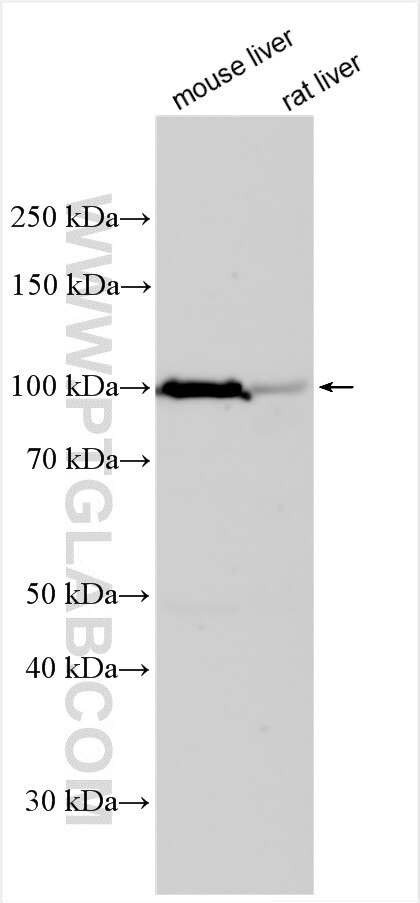OSBPL5 Polyclonal antibody
OSBPL5 Polyclonal Antibody for WB, ELISA
Host / Isotype
Rabbit / IgG
Reactivity
human, mouse, rat
Applications
WB, ELISA
Conjugate
Unconjugated
Cat no : 27870-1-AP
Synonyms
Validation Data Gallery
Tested Applications
| Positive WB detected in | mouse liver tissue, rat liver tissue |
Recommended dilution
| Application | Dilution |
|---|---|
| Western Blot (WB) | WB : 1:2000-1:12000 |
| It is recommended that this reagent should be titrated in each testing system to obtain optimal results. | |
| Sample-dependent, Check data in validation data gallery. | |
Product Information
27870-1-AP targets OSBPL5 in WB, ELISA applications and shows reactivity with human, mouse, rat samples.
| Tested Reactivity | human, mouse, rat |
| Host / Isotype | Rabbit / IgG |
| Class | Polyclonal |
| Type | Antibody |
| Immunogen | OSBPL5 fusion protein Ag27304 相同性解析による交差性が予測される生物種 |
| Full Name | oxysterol binding protein-like 5 |
| Calculated molecular weight | 811 aa, 91 kDa |
| Observed molecular weight | 100 kDa |
| GenBank accession number | BC032646 |
| Gene symbol | OSBPL5 |
| Gene ID (NCBI) | 114879 |
| RRID | AB_3669627 |
| Conjugate | Unconjugated |
| Form | Liquid |
| Purification Method | Antigen affinity purification |
| Storage Buffer | PBS with 0.02% sodium azide and 50% glycerol pH 7.3. |
| Storage Conditions | Store at -20°C. Stable for one year after shipment. Aliquoting is unnecessary for -20oC storage. |
Background Information
OSBPL5, also known as oxysterol binding protein like 5, is a protein-coding gene in humans. It is a member of the oxysterol-binding protein (OSBP) family, which consists of intracellular lipid receptors that play a crucial role in maintaining cholesterol balance in the body. It is expressed ubiquitously in various tissues, including the spleen and endometrium. OSBPL5 is classified as a plasma protein and transporter, with a predicted subcellular location in the membrane and intracellular compartments. The protein has been implicated in several biological processes and is involved in the transport of lipids and other molecules between organelles. In terms of disease association, OSBPL5 has been linked to conditions such as Lenz-Majewski hyperostotic dwarfism. Additionally, the OSBPL family of proteins, including OSBPL5, has been suggested to play a role in cancer development, although specific roles in different types of cancer are still being investigated (PMID: 36918840). The molecular weight of OSBPL5 is 98 kDa.
Protocols
| Product Specific Protocols | |
|---|---|
| WB protocol for OSBPL5 antibody 27870-1-AP | Download protocol |
| Standard Protocols | |
|---|---|
| Click here to view our Standard Protocols |


